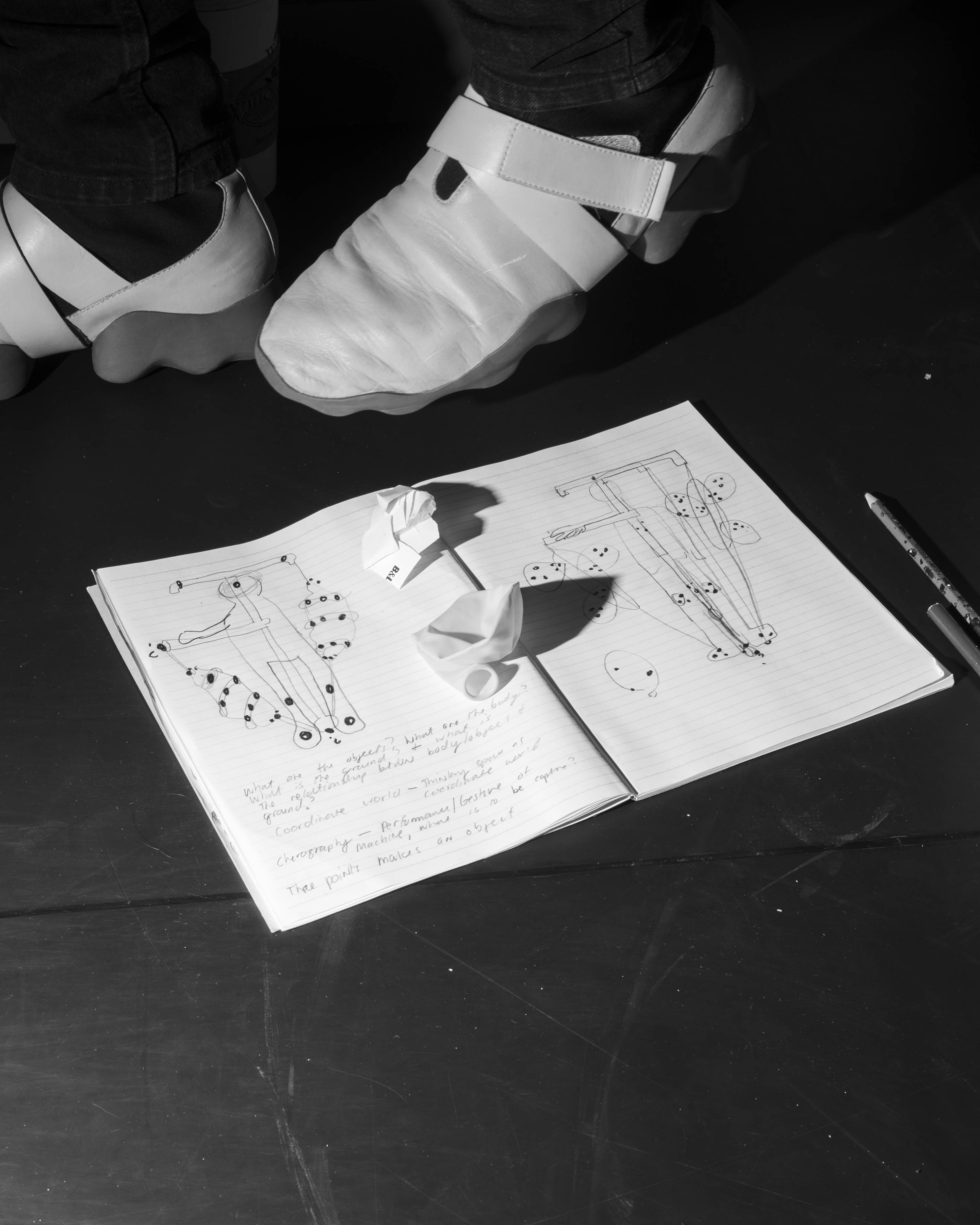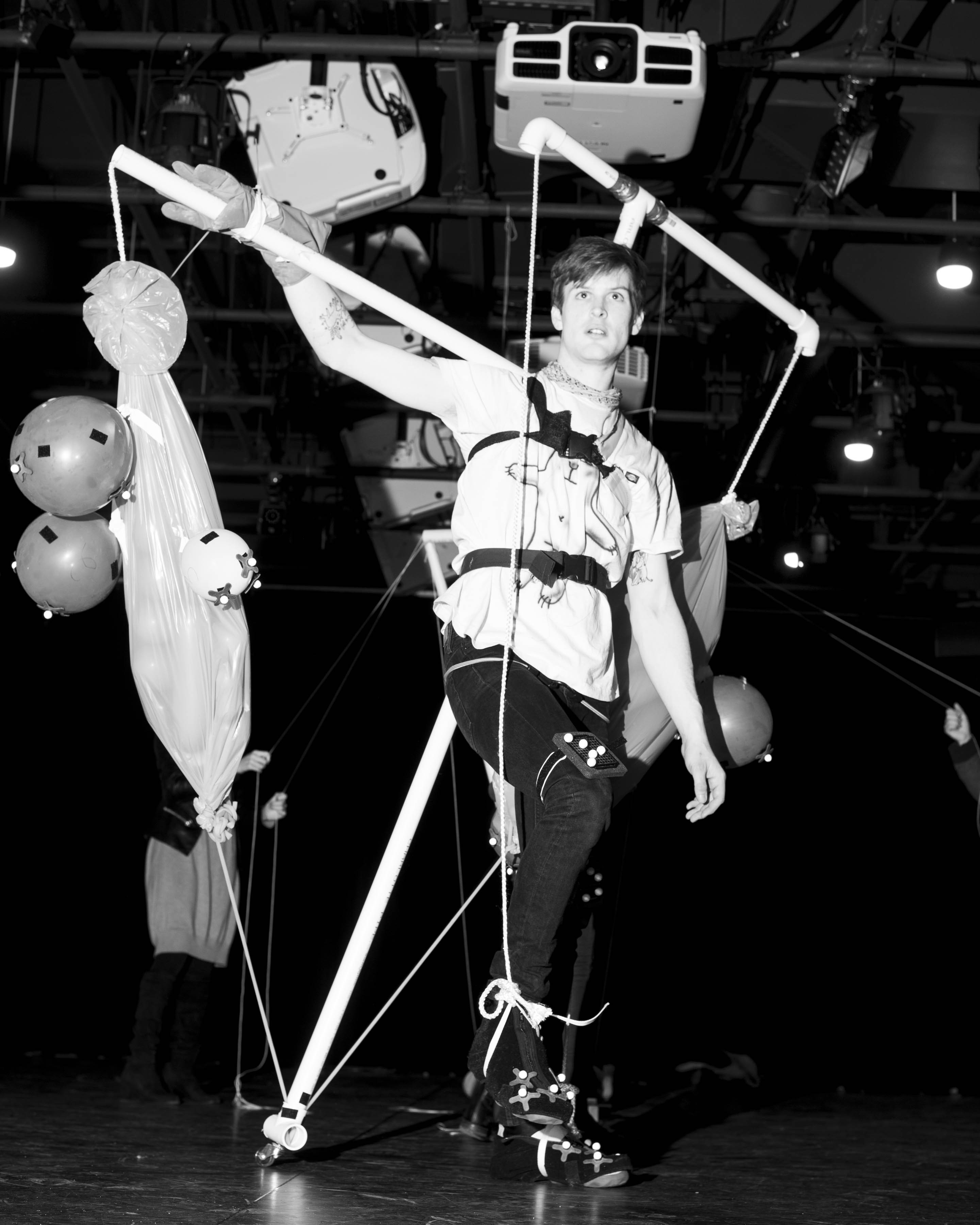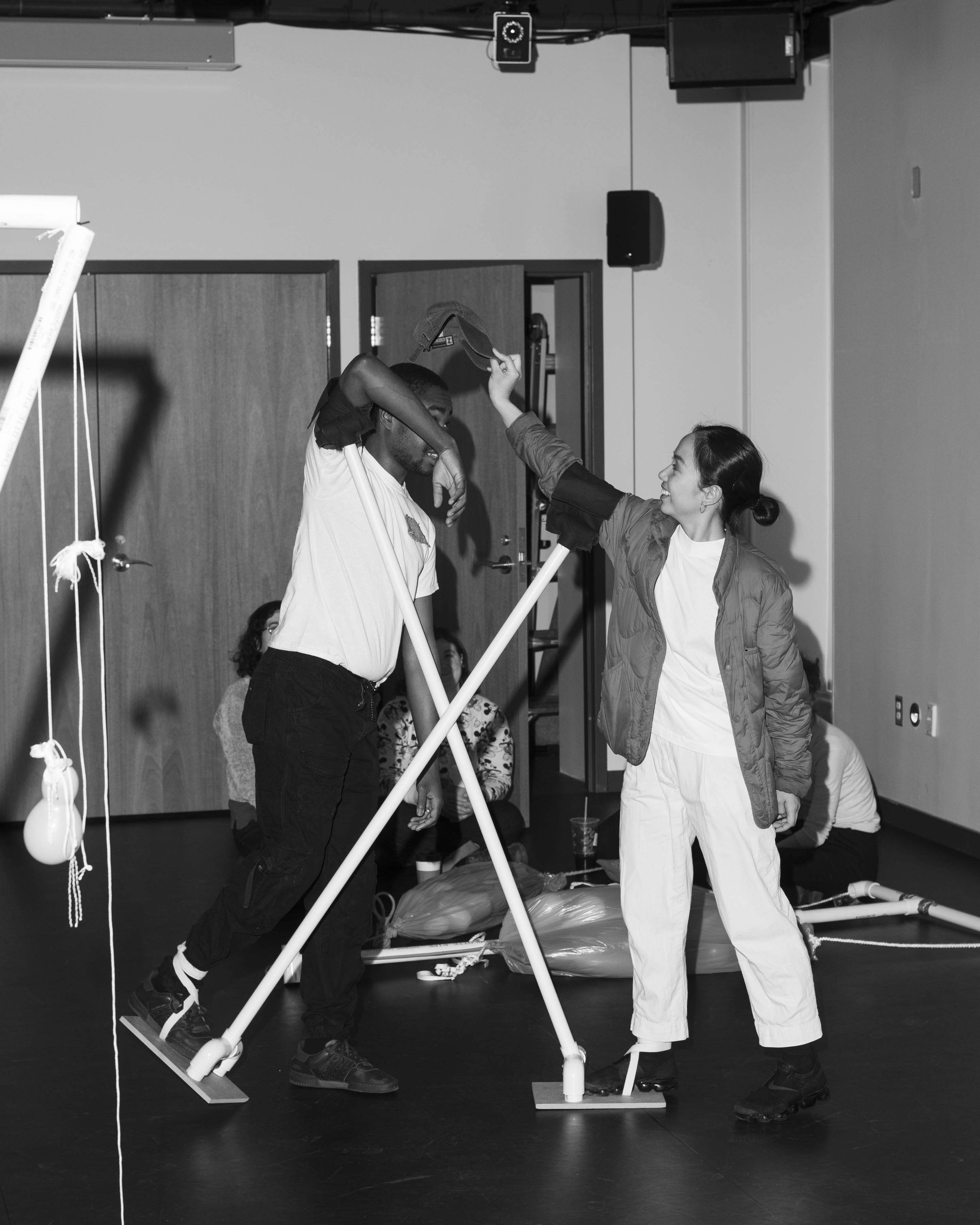︎Ultra-Space︎Dana Karwas in
conversation with Sarah Oppenheimer︎Ultra-Space︎Dana Karwas in
conversation with Sarah Oppenheimer
︎Ultra-Space︎Dana Karwas in conversation with Sarah Oppenheimer︎Ultra-Space︎Dana Karwas in conversation with Sarah Oppenheimer

All images by Brian Galderisi, MFA 2019.
Ultra-Space
Dimension, Gesture, and “The Sensitive Machine”
Dana Karwas in conversation with Sarah Oppenheimer
Dimension, Gesture, and “The Sensitive Machine”
Dana Karwas in conversation with Sarah Oppenheimer
When my mother-in-law was being diagnosed with Alzheimer’s many years ago, she was given a test to measure her cognitive function across a variety of aptitudes, such as short-term recall or spatial reasoning. One of the tests involved an attempt to perfectly reproduce two intersecting pentagons:

Later, during a workshop at the Alzheimer’s Association to teach caretakers how to empathize with and understand the disease better, an instructor asked us to perform the same task. To simulate the difficulty that patients face, though, she asked us to do it while looking in a mirror and not at our hands. Given that additional wrinkle, the task was surprisingly challenging. What had seemed trivial and easy—drawing a few platonic solids—had become frustrating. Our own hands and eyes were betraying us.
The instructor explained that this was meant to be an exercise in understanding the challenges that the patients face every day. We were being asked to look at the mundane, everyday gestures of our own lives and consider how seemingly small re-orientations or transformations in perspective could render them unfamiliar, even alien.
I’ve always been interested in these kinds of perspectival shifts—of turning something on its head to reveal something new. There’s a certain alchemy in taking that mundane event and eliciting a new source of knowledge from it. In “The Sensitive Machine”, a workshop collaboratively taught by artist Sarah Oppenheimer and mechanical engineer Joseph Zinter, students conduct a similar alchemy. They take a simple gesture and examine it through a variety of different lenses, all meant to re-orient the students’ perspective and reach new orthogonal understandings of that gesture.
During a recent iteration of “The Sensitive Machine”, I saw a student wearing a plastic exoskeleton of sorts, which itself was connected to a series of pulleys being operated by a cluster of fellow student puppeteers. Tugging and pushing, their human marionette and mechanized limbs moved with a strange, distended grace. For the observer, it was hard to tell who was steering—what was self-generated motion, and what was driven by the outside pulleys? In some cases, the movements seemed to recall a spider navigating its web, while others were more delicate, fluid, and sinuous. All the while, the various pipes and string punched out their own rhythmic accompaniment to this silent play.

Witnessing this live investigation of homology was delightful, and it made me think about other iterative loops in alternate settings and areas of work. The students themselves were obviously enjoying the process. This reminded me of another aspect of the exercise from the Alzheimer’s workshop. Drawing pentagons wasn’t simply for caretakers to understand or simulate the difficulties their loved ones were facing. It was meant to equip them with a new emotional tool. Instead of looking at a single activity—tying shoes, or putting on a shirt—as something with an obvious goal wherein non-achievement is a source of frustration, the idea was to adopt a different perspective. One that allows a person to be present in the moment, and intellectually and emotionally respond to the process.
Oppenheimer received a BA from Brown University in 1995 and an MFA from Yale University in 1999. Her work has been featured in solo exhibitions at Kunsthaus Baselland, Muttenz, Switzerland; MASS MoCA, North Adams, Massachusetts; Mudam Luxembourg, Musée d’Art Moderne Grand-Duc Jean, Luxembourg; the Pérez Art Museum Miami, Florida; and the Wexner Center for the Arts, Ohio State University, Columbus. She is a recipient of the Rome Prize Fellowship (2011–12), Louis Comfort Tiffany Foundation Fellowship (2009), and Guggenheim Foundation Fellowship (2007). She is currently a senior critic at the Yale University School of Art.

Sarah Oppenheimer: The workshop was an exploration of the body as a mechanical instrument. Students constructed human-powered mechanisms to isolate and amplify a simple gesture. Each gesture was augmented by the introduction of an external mechanism. As students began to explore the sensorial feedback between prosthetic and body, they learned how the prosthetic altered the form of the initial gesture. Students were then required to redesign their mechanical instrument, so that each was collaboratively controlled. The collective control of the prosthetic affected the motion of multiple students simultaneously.
DK: When you were observing this coming together of two bodies, or systems, working in a single communal motion, were you recognizing it as a motion that you had a memory of, or was it something new in your mind?
SO: The isolation of a single gesture created a conscious awareness of the action and thereby altered the memory of the movement. Mechanical extension and collaborative control compounded this alienation, creating a new self-awareness.
︎
Mechanical extension and collaborative control compounded this
alienation, creating a new
self-awareness.
DK: That brings up another point about the motion capture studio in general. When I was observing the workshop, there was this discussion of maybe hacking into, or disrupting that system, and to interact with it outside of the bounds of what it is normally used for. Some of the students were using it in the same way a dancer would, or as someone tracking an object. But when I was looking at the screen, this other intangible space was appearing, as they moved. There was a duality in watching them on a screen as well. It formed this other world, or other outside observation of it. Do you have any thoughts about the idea of disrupting that system?
SO: This is incredibly interesting. The motion capture studio measured the moving communal mechanical body. Recorded data was relayed from ceiling-mounted cameras to ceiling-mounted projectors and displayed a dynamic point cloud image. Simultaneous feedback triggered a performative condition. Students adapted their motion to match the abstracted image of their movement. Disrupting or modifying this feedback could shift this adaptive process, and alter how recorded movement is re-integrated into each student’s sensoria.
DK: In one way, I was thinking about this idea of the proprioceptive feedback, or the sensory conduit in the workshop description… and the live quality of it. Maybe it’s there, but—
SO: Dana, before you throw that in, there is another important question: Did the participants in the workshop experience the projection as a kind of proprioceptive feedback? And did that, in turn, upset the way they used or manipulated their prosthetic machine?
DK: Right. Maybe it was introducing a way in which they were extending that sense of orientation and control on the screen, even though it was a very casual and random camera set-up. It reminds me of a cognitive test that they give to Alzheimer’s patients. They ask them to copy a drawing of two pentagons that overlap at different angles, as accurately as they can. To experience the same test at my own level of functioning, I was asked to perform the same task, but the pentagons were held up in a mirror. I was not allowed to look at my hands as I drew them. It was really difficult, to draw from a mirror.
︎When I was looking at the screen, this other
intangible space was appearing, as they moved.
SO: This would create a fascinating study: A student makes a gesture, motion capture records it, and then the student tries to mimic the gesture. “The Sensitive Machine” aside, this makes me think of language acquisition...

DK: Yes, because then that would use
that intangible, digital mirror space, as something that will feedback into the
motion or physicality of it. It’s almost a form of inversion as well, because
it asks questions about orientation and location, and the mind would really
have to work it out, through recalibrating and flipping into point symmetry.
This takes the idea of proprioception into another dimension… We should try it!
We could set up a little experiment. There are probably many documented images
of the cognitive function test, in two-dimensional form as well. And then we’d
be blowing it into three-dimension with time and movement.
DK: I was reading about proprioception with a friend, Elizabeth Hénaff, who was considering astronaut training. She’s an artist and computational biologist, and we were discussing different proprioceptive tests that the body has to go through for that training. Then I was reading about this one astronaut who, when he was up in the weightlessness of space, completely lost track of the positions of all his limbs. He said that the only way he was able to regain control was to consciously tell his body to move his arm. It made me think about the active sensory conduit that the workshop is investigating, between the machine and the body; but also, further into the question of: Is there a conscious knowledge that is built into what they’re doing? How do you think this motion data can help our body know where it is? Or: if they’re looking at this data and they go back and do another iteration of the bodily extension—is there something the mind is doing, that is telling them to move a certain way? What is controlling their movement?
SO: This is such an important question. I think that the way you’re asking it opens up the possibility of the motion capture studio evolving as a component of “The Sensitive Machine”, so that it’s no longer just a recording space. It senses us, and then we sense it in turn. And I think that if there is a way to integrate that, it would likely require more time, but also a much more modest action, because the exuberance of “The Sensitive Machine” led to a sensory overload. Perhaps we should begin by mimicking a seemingly simple gesture or mechanical motion… of course, nothing’s simple…
DK: I’m thinking also of the knowable versus the binary or technical; having that as two ways, because there is this hard line with the data that they can just look at, but then that too becomes part of it. But I think that the extending of it into the space, like you’re saying, could feel like yet another layer. This in turn could be integrated as a system into it.
SO: I’m so excited. Let’s do this, and let’s publish a second follow-up as a result!
Stay tuned!
